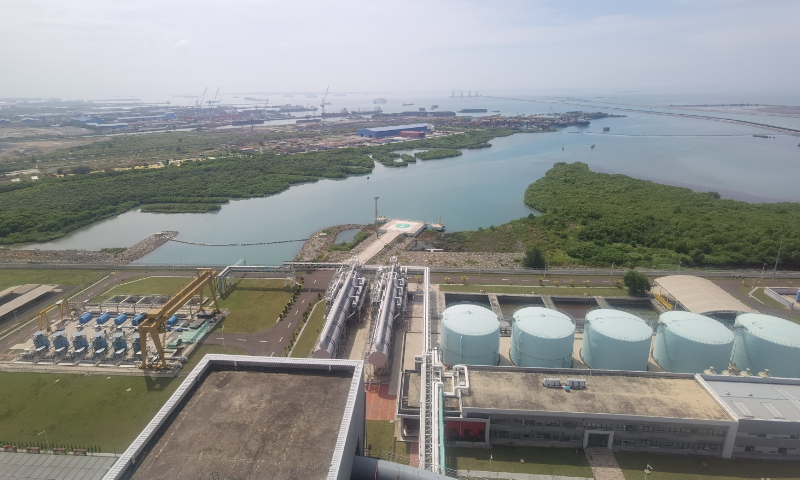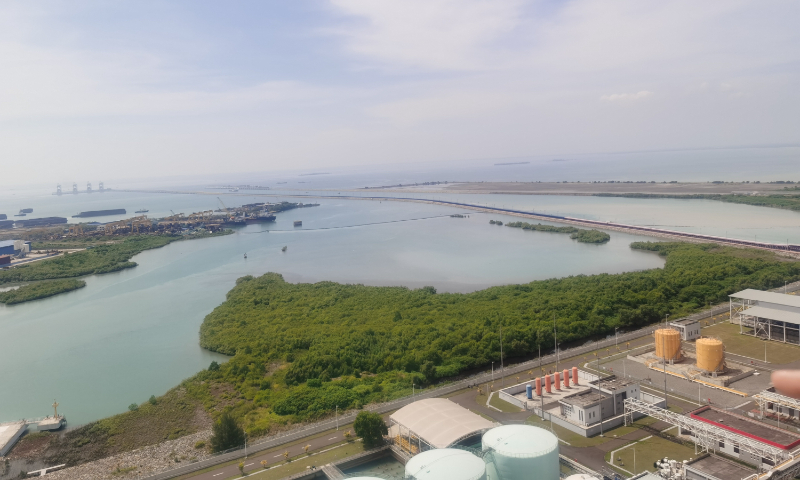BRI witnesses China's transfer of low-carbon, environmentally friendly power plants to Indonesia

The Jawa 7 coal-fired Power Plant located in Indonesia Photo: Hu Yuwei/GT
Standing on the observation platform of the Jawa 7 coal-fired Power Plant in Indonesia, one enjoys a panoramic view of the lush and vibrant mangrove forest, where numerous marine birds frolic and mate. It is difficult to associate this idyllic scene with the image of a traditional power plant, billowing black smoke engulfing the surroundings and causing air pollution. And yet the image couldn't be further from the truth as this is one of the most efficient, stable and environmentally friendly power plants in Indonesia, co-built by Chinese and Indonesian constructors under the framework of Belt and Road Initiative (BRI).
On December 13, 2019, Unit 1 of Java 7 was put into power generation four months ahead of schedule, and the whole plant was put into commercial operation on July 8, 2021. The project, built through a joint venture between China Shenhua Energy and Indonesia's state-run power company PT Pembangkit Jawa Bali (PJB), consists of two sets of 1050 mW-generating units, with an annual power generation capacity of approximately 15 billion kilowatt-hours, marking it the largest single capacity, highest parameter, and most advanced power plant in Indonesia.
The main environmental indicators are considerably superior than the local emission standards, and it has become a model for local low-carbon and environmentally friendly power generation with advanced technology, Zhao Zhigang, head of the plant's developer PT Shenhua Guohua Power Jawa Bali, told the Global Times.
"The project placed significant emphasis on environmental protection during construction and operation, resulting in the creation of this wetland landscape where people and nature coexist in harmony," Zhao said. He noted that in Southeast Asian countries, local residents attach great importance to environmental protection and consider the good natural environment to be an important foundation for sustainable development. Based on this common recognition, protecting the region's mangrove forest has become a shared responsibility for Chinese and Indonesian operators of the power plant.
To safeguard the rare mangrove forest from harm, a series of measures have been put into action, including the planning of mangrove ecological protection zones, the reintroduction of dominant mangrove tree species, the installation of mangrove protection signage, and the appointment of dedicated personnel to oversee mangrove preservation in various regions. Chinese contractors also take the initiative to seek cooperation with local mangrove conservation agencies, and the company spends more than 200,000 yuan ($27,443.12) a year on mangrove protection, Zhao said.
Zhao mentioned that throughout the construction period, any large construction machinery had to follow alternative routes to circumvent the mangrove forest.
When Global Times reporters visited the power plant in July, the area of the mangrove forest had expanded from 9 hectares when the construction began to approximately 17 hectares. It has become an ideal home for marine birds, lizards, mongooses, and other animals. Nearly 3,000 different marine bird species nest in this mangrove forest. Lizards, otters, snakes, crabs, fish, and other species safely reproduce here.
As the sun sets, a 4-kilometer-long pipeline, coated in seven-color anti-corrosion paint, comes into sight, representing the coal transport facilities. It serves as the "lifeline" of the power plant, connecting it to the dedicated coal terminal like a rainbow ribbon. Zhao elaborated that the coal conveying system on the bridge employs a green and environmentally friendly enclosed conveyor belt, significantly reducing coal dust emissions. "It is the longest and fastest pipe belt conveyor for coal transportation in Indonesia," said Zhao.
Additionally, the power plant utilizes new generation low-nitrogen burners, and seawater desulfurization processes, achieving an overall desulfurization efficiency of up to 99.65 percent, significantly higher than local standards. The company has also left room for further optimization of emission standards.
Indonesian President Joko Widodo inaugurated Jawa 7 in 2017. "The PLTU adopts ultra-supercritical technology which is environmentally friendly and allows higher energy conversion efficiency compared to the previous PLTU conventional technology," the Indonesian Energy Ministry spokesman Dadan Kusdiana stated in a press release upon Widodo's visit.

The Jawa 7 coal-fired Power Plant located in Indonesia Photo: Hu Yuwei/GT
Zhou Lisha, a researcher with the research institute of the State-owned Assets Supervision and Administration Commission of China's State Council, believes that as the first independently developed supercritical million-kilowatt thermal power unit with independent intellectual property rights, the Jawa 7 will be practical in showing the world that China's international energy cooperation under the BRI is not about exporting outdated production capacity, but about exporting the most advanced and efficient clean energy technologies.
Indonesia is strategically located between the Pacific Ocean and the Indian Ocean, with unique advantages in location, population, market, and resources, and holds enormous potential. However, the shortage of electricity supply has been constraining its development.
As of the end of 2022, the plant has generated a total of 31.5 billion kilowatt-hours of electricity and paid $45.64 million in taxes. It greatly alleviates electricity shortages in the Java region, and is also a strong driver for local economic growth and social development.
The Global Times has learned that the power plant is an industry reliant on advanced technology; however, Indonesia faces a shortage of relevant academic programs in universities and talent development systems to support it. Job opportunities provided by Chinese companies are seen as good learning opportunities for many local people after graduation. It is estimated that during the operation period, it has provided nearly 700 jobs for local graduates.
Rizka Anggraini, a local employee at the project, told the Global Times that currently, Indonesian employees account for about 70 to 80 percent of the project's workforce. After graduating, she chose to join a Chinese company in the hope of seeing how traditional energy technologies in China achieve near-zero emissions.
"We implement a mentorship system in the project, and my Chinese mentor provides me with detailed guidance. Indonesians also have good opportunities for promotion," Anggraini said.
She also mentioned that Chinese companies annually organize visits for top Indonesian employees to power plants in China for educational purposes, and she eagerly anticipates the chance to participate in one of these visits.

